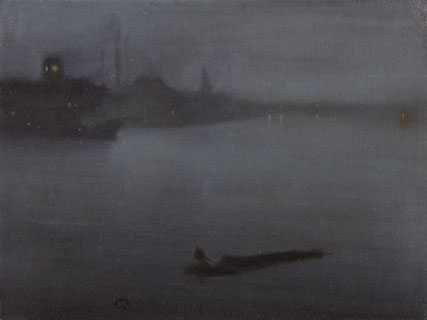
James McNeill Whistler (1834–1903)
Nocturne in Blue and Silver
1872–78
Oil on canvas
Whistler adapted the term ‘nocturne’ from the piano miniatures of Fryderyk Chopin that were widely admired throughout the Victorian era and beyond (an example can be heard at the listening station in this room). Written at about the same time as Mendelssohn’s Lieder ohne Worte (nineteen appeared between 1832 and 1846), the nocturnes were remarkable for their atmospheric sonorities. Mainly slow and reflective, sustaining a single mood throughout, their overwhelming effect is one of contemplative melancholy. The same could be said of Nocturne in Blue and Silver.Whistler theorized the relationship between art and music in his Ten o’clock Lecture of 1885:
Nature contains the elements, in colour and form, of all pictures, as the keyboard contains the notes of all music. But the artist is born to pick, and choose, and group with science, these elements, that the result may be beautiful — as the musician gathers his notes, and forms his chords, until he brings forth from chaos glorious harmony.
As well as harmonious compositions, Whistler’s paintings of this title are literally nocturnes — representations of nighttime. The artist would often ask to be rowed out into the River Thames by his assistants, the Greaves brothers. He saw great beauty in the desolate buildings of the Battersea wharfs by night: “tall chimneys become campanili and warehouses are palaces in the night.” Making no sketches, he merely observed the scene, executing his painting only when he returned to the studio.
Whistler signed the painting, perhaps during the 1880s, with a stylized butterfly, his monogram. He admired the insect for its beauty, delicacy, and lack of any useful purpose, qualities he ascribed to art itself.
YALE CENTER FOR BRITISH ART, PAUL MELLON FUND
B1994.19
